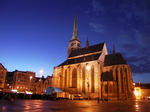
Plzen (the Square) is situated 1010 ft above sea level in the Plzen basin (Plzenska kotlina) which is bounded to the north by the Krkavec downs (Krkavecka pahorkatina), to the southeast by the Radyne highlands (Radynska vrchovina) and to the east by the Radec belt (Radecske pasmo). The Plzen basin is the easternmost and, at the same time, the lowest part of the West Bohemian basin.
The four largest rivers of the basin - the Mze, Radbuza, Uhlava and Uslava - meet in Plzen. The Uhlava flows from Klatovy, then into the Radbuza which originates from Stankov in the southern part of Doudlevce near the waterworks at a height of 981 ft. The Radbuza flows through Plzen and beyond the city brewery into the Mze at a height of 971 ft above sea level. The Mze flows to the city from Radcice. The Uslava flows from Stahlavy through Bozkov, Lobzy and Letna, then into the Mze in Doubravka at a height of 965 ft above sea level.
The Square of the Republic (Namesti Republiky)
measures 552 x 627 ft and is one of the largest medieval squares in the Czech Lands. It is divided by Riegrova and Drevena Streets into two parts - north and south.
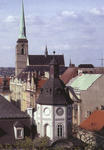
In the smaller northern half there stands St. Bartholomew's Church. In the past there was a graveyard around the church - this was abolished by Emperor Joseph II. in 1789.
Between the town hall and church, close to the sacristy, there used to be the splendid Renaissance building of
the city's Latin School - this was demolished in 1829.
In every corner of the square there was a French Imperial fountain. The fountain in the north-east corner was in Baroque style and bore a statue of Roland, known in Plzen as Zumbera: in 1919 this was transferred to the Emperor's house alongside the town hall.
The square was cobblestoned in 1859. The buildings in the square still contain predominantly Gothic and Renaissance elements in the foundations, cellars and stonework.
In the courtyards on the east side, especially in courtyard no. 107, remains of the medieval walls are still preserved. The best preserved part of the square is its southern facade.
St. Bartholomew's Church is an outstanding building dating from the late 13
th to early 16
th century.
It combines three developmental Gothic features on the principle of a three-part nave entrance hall. It is the dominant architectural feature of the city. Building of the cathedral commenced at the end of the 13
th century with the presbytery, now no longer standing.
The town hall dominates the north side of the square. In 1496 the Plzen people purchased the largest building in the city and converted it into a
town hall. The town hall was damaged by a large fire in 1507. On the occasion of a visit to the city by some Italian bricklayers and stonemasons, the burgesses commissioned the Italian master-builder Giovanni de Statia to reconstruct the building into a splendid Renaissance palatial residence. Today it is an imposing three-storey building.
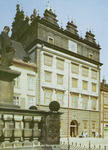
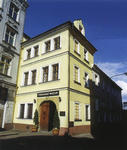
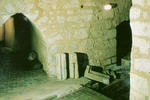
 Guide
Guide 





